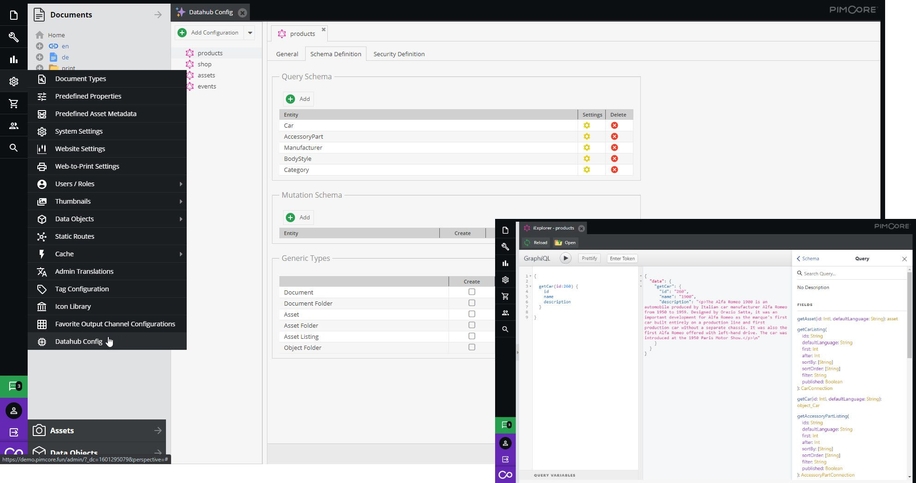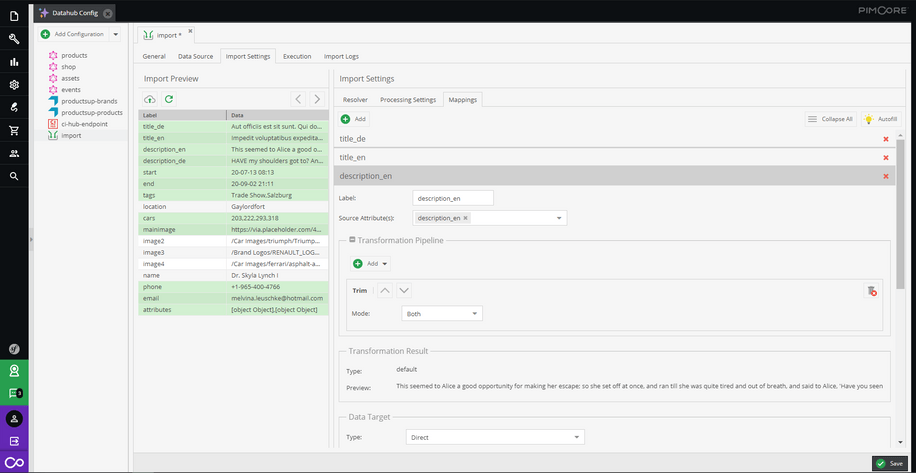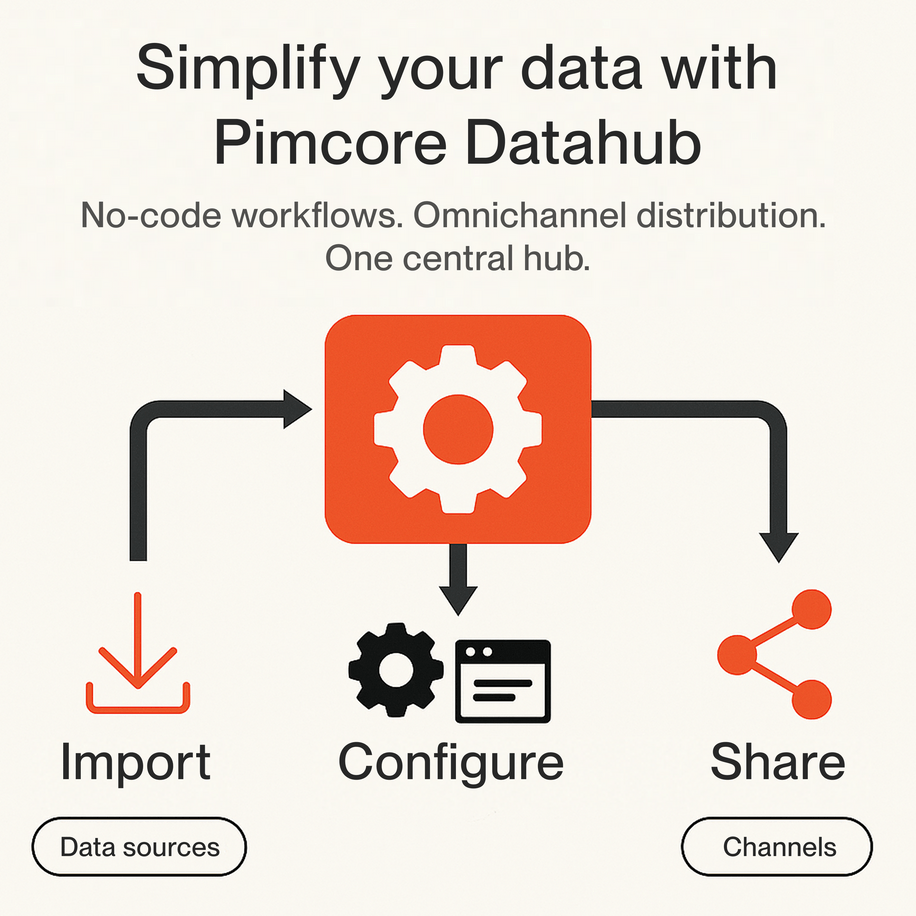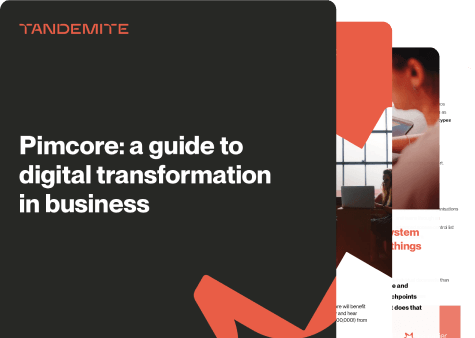Import, configure, share data: Pimcore Datahub makes that simple for everyone

Are you evaluating PIM solutions and feeling like all the options blur together? Not all PIMs are created equal, and one standout feature that can make your life a lot easier is Pimcore Datahub.
Managing your business data doesn't have to feel like black magic or require constant developer involvement. From B2B manufacturers handling countless spreadsheets to update distributors, to wholesalers scrambling to push product data to dozens of retailer websites, we’ve seen the challenges firsthand. With Pimcore Datahub, they gain a powerful solution to import, configure, and distribute their data seamlessly.
In this article, we cover:
- What is Pimcore Datahub?
- Why your business might need Pimcore Datahub
- Do you need a developer to use Datahub?
- 5 ways Datahub simplifies data management
- What Pimcore Datahub isn’t (clearing up misconceptions)
What is Pimcore Datahub?
Pimcore Datahub is often described as a “data delivery and consumption platform” for Pimcore.
But what does that actually mean? In essence, Datahub is a module inside Pimcore that integrates different input and output channels into one easy-to-use system.
Think of Datahub as the central switchboard for all product information that flows into – and out of – your Pimcore, without custom coding every integration.
It takes the product data you’ve carefully managed in Pimcore and makes it available to any external system that needs it, in the format that system requires.
You decide which Pimcore data (products, assets, customer info, etc.) should go where – be it your eCommerce website, a mobile app, an ERP system, or a partner portal – and Datahub routes that information accordingly.
Importantly, Pimcore Datahub is built into Pimcore’s core platform, not a separate product. Whether you’re using the free Community Edition or the Enterprise Edition, Datahub is there to help you get data in and out.
Datahub’s default mode is GraphQL, but it’s not limited to just that.
Datahub’s architecture is modular. If GraphQL isn’t your thing, Pimcore software also supports traditional RESTful APIs (available in Enterprise Edition), and even file-based imports/exports through Datahub adapters, so there’s always an integration method that fits.

(Source: Pimcore.com)
Why your business might need Pimcore Datahub
If you’re part of a B2B, manufacturing, distribution, or e-commerce company, you’re probably surrounded by data (product specs, certifications, and a host of digital assets). But the real challenge isn’t just managing it; it’s ensuring consistency across every system and sales channel. That’s the problem Pimcore Datahub is designed to solve.
✔ Imagine you’re a manufacturer who needs to update dozens of distributors about a product change. Without a central hub, you might be emailing spreadsheets or relying on each distributor’s IT team to manually import updates. Not only is that slow, but it’s also prone to errors. With Pimcore Datahub, you could instead maintain the product info in Pimcore and configure an export or API endpoint that distributors can pull from automatically.
✔ For a distributor or retailer, the scenario might be reversed. Say you receive product catalogs from 50 different suppliers in different formats. Pimcore Datahub’s importer can take those various files and feed them into your Pimcore master database in a standardized way. You set up mappings once, and the next time you get a new product feed, it’s a few clicks to import and update, rather than a few days of manual data entry.
✔ E-commerce companies can benefit hugely, too. They often need to syndicate product information to multiple sales channels – their own website, Amazon, Google Shopping, maybe a print catalog. Datahub allows you to configure multiple endpoints for different channels, each with the specific data and format required.
Do you need a developer to use Pimcore Datahub?
One of the best parts about Pimcore Datahub is that it’s designed to empower business users and technical teams alike to configure data connections through a user interface. In fact, you often don’t need a developer at all for day-to-day data handling.
Take the Data Importer feature, for example. This is an add-on to Datahub that lets you set up data imports from external sources (spreadsheets, JSON/XML feeds, etc.) via a configuration screen. You can map columns from an Excel file to fields in Pimcore, set rules for how to handle existing records vs new ones, and even preview the import. That means someone on your team (maybe a data manager or PIM administrator) could configure an import job without having to involve a software developer to write a custom script.

(Source: Pimcore.com)
The same “no-code” philosophy applies to exporting or exposing data. Want to provide a REST API endpoint for your product data? Datahub has a configuration for that – you pick which data objects and fields to expose, maybe set up some filters or permissions, and the system generates the endpoint for you. All of this is done through Pimcore’s admin UI with forms, checkboxes, and drop-downs. It’s designed so that a technically inclined business user or an IT power user can manage it once they know their way around Pimcore.
Of course, while you don’t need a developer for most configuration tasks, you might still involve one for the initial setup or more complex scenarios. Installing Pimcore and the Datahub extensions, for instance, is typically done by a developer or system administrator. Additionally, if you have very unique integration requirements (custom data source or non-standard output format), a developer can extend Datahub’s functionality via its APIs and plugins.
For everyday usage, though, your team should be able to handle Datahub configurations.
5 ways Pimcore Datahub simplifies data management
How exactly does Pimcore Datahub make life easier? Let’s break down some of its key capabilities and how you can leverage them to streamline your data management. Here are five major benefits and features:
1️⃣ Centralized data “switchboard”: Pimcore Datahub turns your Pimcore platform into a central hub for all data exchanges. Rather than piecing together integrations one by one, you have a single place to configure connections to ERPs, CRMs, eCommerce shops, mobile apps, and more. This centralization means you maintain one source of truth and simply share it – no more conflicting datasets in different departments or channels.
2️⃣ No-code data import & onboarding: Bringing external data into your system is often tedious. Datahub’s importer eliminates the need for custom import scripts. You can define multiple import configurations right in Pimcore for different sources. It supports common file formats like CSV, Excel (XLSX), JSON, and XML.
Using a visual mapping interface, you match source data fields to Pimcore fields, apply simple transformations if needed (like converting text to a date format), and you’re done. Schedule these imports or run them on-demand – either way, it’s much faster than manual data entry and less error-prone.
3️⃣ Easy data transformation & mapping: Real-world data is messy – maybe your ERP calls a field “Prod_ID” but your website calls it “Product SKU”. Datahub lets you handle these discrepancies.
Through its graphical user interface (GUI), you can transform and map data fields during both import and export. For example, you could concatenate two fields into one, do find-and-replace operations, or apply calculations, all as part of the configuration. This ensures that the data arriving in Pimcore or leaving Pimcore is in just the right shape for the target system, without having to clean up spreadsheets or maintain complex Excel formulas.
Datahub respects Pimcore’s permissions and lets you define workspaces/schemas to restrict what data is exposed. If you only want to share a subset of attributes or products with a particular channel, you can do that.
4️⃣ Multi-channel data distribution: Once your data is in Pimcore, Datahub makes it simple to share that data anywhere it needs to go. It’s called “Datahub” for a reason. You can set up multiple endpoints or feed configurations for different purposes. Need an API for your e-commerce site? Enable the GraphQL or REST endpoint, and your front-end developers can fetch data live. Need a daily export of product info for a partner? Use the file export adapter to generate and deliver a JSON or CSV file automatically. Each endpoint can be tailored to its audience. Pimcore Datahub even supports event-based distribution (using webhooks) if you want instant push notifications when something changes.
Essentially, it gives you omnichannel publishing power on tap. You get a central GUI to define what data is exposed and how it’s structured for each target. This means no digging into code or writing custom scripts just to get your data from point A to point B.
Business impact: Shorter integration cycles directly translate to faster time-to-market for new channels and initiatives – a key concern for any business looking to stay ahead of the competition. And for the C-suite, faster time-to-market and fewer developer hours also mean a better ROI on your PIM investment.
5️⃣ Reduced dependency on IT: Another big benefit is how Datahub shifts the power into the hands of your business.
Here’s a concern we hear often: “Do I need developer skills or experience with APIs to use Datahub?” The answer is no. Pimcore Datahub is made to be straightforward and user-friendly, suitable for both developers and business users. Our clients are a great example – after training, they’re able to manage their data confidently on their own.
Instead of writing a requirements doc for the IT department, your team can often configure what’s needed in a day via Pimcore’s back-end interface. You’ll find menus and forms to define your data output: choose which class of data or which specific fields to expose, set up filters (e.g., only active products, only certain categories), and so on.
By minimizing the need for developer intervention, Datahub saves time and cost. You can respond faster to new integration demands – for instance, a new retailer wants your product feed in a slightly different format? No problem, clone an existing Datahub export config, tweak the fields, and you’re set.
For those who prefer more familiar formats or have one-time needs, Datahub also supports old-fashioned data export/import via CSV or Excel through its adapters. Datahub covers the spectrum from low-code to no-code options, which lowers the barrier for your team to manage product data flows.

What Pimcore Datahub isn’t (clearing up misconceptions)
To fully understand Datahub, it helps to clarify what it is not. There are a few misconceptions we’ve encountered when discussing Pimcore Datahub with businesses who are comparing PIM solutions. Let’s clear those up:
Not a separate pricey add-on: Datahub is part of Pimcore’s open-source framework. If you’re using Pimcore, you have Datahub. There’s no separate “integration module” you need to buy to unlock basic connectivity – it’s included even in the Community Edition.
(Of course, certain specialized connectors like the Productsup integration might involve third-party services, but the core Datahub capability is built-in and free to use.)
Not just for developers: Yes, Datahub exposes APIs, but that doesn’t mean only developers can benefit. As discussed, Pimcore provides a UI for configuring those APIs, so business users and tech leads alike can play a role. Your non-dev team members will love it because they’re not completely dependent on IT for every little data sync need.
Not an ETL or ESB replacement: Datahub isn’t a full-blown enterprise service bus (ESB) or dedicated ETL (extract-transform-load) tool – it’s focused on Pimcore data. However, Pimcore as a whole has additional tools like the Data Importer and workflow engine, and it can connect with iPaaS solutions. So while Datahub by itself handles the Pimcore side of integration brilliantly, complex multi-system orchestration can be achieved by combining it with those tools. The good news is that most of your day-to-day PIM integration needs won’t require anything beyond Datahub’s capabilities.
Not a security risk: Datahub respects all of Pimcore’s robust security and permission settings. You explicitly choose what data to expose and to whom. Endpoints can be secured with API keys or OAuth tokens as you prefer. Pimcore’s role/user permissions also ensure that only authorized data gets out.
By now, we hope you have a clear picture of what Pimcore Datahub is and why it’s such a compelling feature of the Pimcore platform.
Datahub is a powerful ally in the quest for efficient data management. You get a central, configurable, and code-free way to import, transform, and distribute the information that drives your business.
For businesses – manufacturers, distributors, wholesalers, and beyond – this means less time fighting with data and more time putting that data to work in new sales channels and customer experiences.
At Tandemite, we specialize in PIM solutions, helping you navigate every twist and turn of the journey. From setting up Pimcore Datahub to optimizing it for your unique needs and integrating all your systems smoothly, we’re here to ride together toward your success. Let’s meet and talk about your plans.






